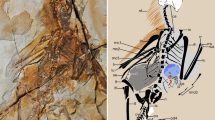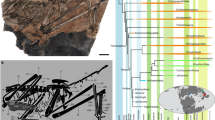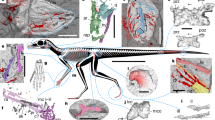Abstract
The spate of recent discoveries of Mesozoic birds has substantially improved our understanding of the early evolution of birds and flight1–5, but has failed to close the morphological gap between the Upper Jurassic Archaeopteryx lithographica, the earliest known bird, and the Dromaeosauridae, the group of non-avian theropod dinosaurs regarded as most closely related to birds6,7. Here we describe a theropod dinosaur from Patagonia, Unenlagia comahuensis gen. et sp. nov., which partially fills this gap. Despite the relatively late appearance of this dinosaur in the fossil record (Upper Cretaceous), several features of Unenlagia are more bird-like than in any other non-avian theropod so far discovered.Unenlagia resembles Archaeopteryx in the morphology of the scapula, pelvis and hindlimb. But several shared, primitive features of the pubis, ischium and hindlimb proportions suggest that Unenlagia may represent the sister taxon of the Avialae (=Aves). The structure of the forelimb suggests that the avian mode of forelimb folding, and the extensive forelimb elevation necessary for powered, flapping flight, was already present in cursorial, non-flying theropod dinosaurs.
This is a preview of subscription content, access via your institution
Access options
Subscribe to this journal
Receive 51 print issues and online access
$199.00 per year
only $3.90 per issue
Buy this article
- Purchase on Springer Link
- Instant access to full article PDF
Prices may be subject to local taxes which are calculated during checkout
Similar content being viewed by others
References
Sanz, J. L., Bonaparte, J. F. & Lacasa Ruiz, A. Unusual Early Cretaceous bird from Spain. Nature 331, 433–435 (1988).
Sereno, P. & Rao, C. Early evolution of avian flight and perching: new evidence from Lower Cretaceous of China. Science 255, 845–848 (1992).
Chiappe, L. M. The phylogenetic position of the Cretaceous birds of Argentina: Enanthiornithes and Patagopteryx deferrariisi. Courier Forschungsinst. Senckenberg 181, 55–63 (1995).
Chiappe, L. M. The first 85 million years of avian evolution. Nature 378, 349–355 (1995).
Sanz, J. et al. An Early Cretaceous bird from Spain and its implications for the evolution of avian flight. Nature 382, 442–445 (1996).
Ostrom, J. H. Archaeopteryx and the origin of birds. Biol. J. Linn. Soc. 8, 91–182 (1976).
Gauthier, J. A. Saurischian monophyly and the origin of birds. Mem. Calif. Acad. Sci. 8, 1–46 (1986).
Wilheim de Moesbach, P. E., Rusca, W. M., Vúletin, A. & Suárez, E. Nuevo diccionario Mapuche-Español., 1–416 (Siringa Ediciones, Buenos Aires, 1993).
Cruz, C. E., Condat, P., Kozlowski, E. & Manceda, R. Análisis estratigráfico secuencial del Grupo Neuquén (Cretácico superior) en el valle del Río Grande, Provincia de Mendoza. I Congr. Arg. Hidrocarb. 2, 689–714 (1989).
Novas, F. E. Alvarezsauridae, Cretaceous basal birds from Patagonia and Mongolia. Mem. Queens. Mus. 39, 675–702 (1996).
Novas, F. E. Anatomy of Patagonykus puertai (Theropoda, Avialae, Alvarezsauridae), from the Late Cretaceous of Patagonia. J. Vert. Paleont. 17, 137–166 (1997).
Novas, F. E., Cladera, G. & Puerta, P. New theropods from the Late Cretaceous of Patagonia. J. Vert. Paleont. 16, 56A (1996).
Wellnhofer, D. Das funfte Skelettexemplar von Archaeopteryx. Palaeontographica (A) 147, 169–216 (1974).
Wellnhofer, P. Das siebte Exemplar von Archaeopteryx aus den Solnhofener Schichten. Archaeopteryx 11, 1–48 (1993).
Psihoyos, L. Hunting Dinosaurs (Random House, New York, 1994).
Jenkins, F. The evolution of the avian shoulder joint. Am. J. Sci. 293A, 253–267 (1993).
Ostrom, J. H. Osteology of Deinonychus antirrhopus, an unusual theropod dinosaur from the Lower Cretaceous of Montana. Peabody Mus. Nat. Hist. Bull. 30, 1–165 (1969).
Martin, L. in Origin of the Higher Groups of Tetrapods (eds Schultze, H.-D. & Trueb, L.) 485–540 (Comstock Publishing Associates, Ithaca, 1991).
Ostrom, J. H. The pectoral girdle and forelimb function of Deinonychus (Reptilia: Saurischia): a correction. Postilla 165, 1–11 (1974).
Walker, C. A. New subclass of birds from the Cretaceous of South America. Nature 292, 51–53 (1981).
Ostrom, J. H. On a new specimen of the Lower Cretaceous theropod dinosaur Deinonychus antirrhopus. Breviora 439, 1–21 (1976).
Chiappe, L. M. Late Cretaceous birds of southern South America: anatomy and systematics of Enanthiornithes and Patagopteryx deferrariisi. Münchner Geowiss. Ab. (A) 30, 203–244 (Verlag Dr Friedrich Pfeil, 1996).
Martin, L. D. & Tate, J. The skeleton of Baptornis advenus (Aves: Hesperornithiformes). Smith. Contrib. Paleobiol. 27, 35–66 (1976).
Marsh, O. C. Odontornithes: a monograph on the extinct toothed birds of North America. United States Geological Exploration of the 40th Parallel, 1–201 (Government Printing Office, Washington, 1880).
Ostrom, J. H. Archaeopteryx and the origin of flight. Q. Rev. Biol. 49, 27–47 (1974).
Gauthier, J. A. & Padian, K. in The Beginnings of Birds (eds Hecht, M., Ostrom, J., Viohl, G. & Wellnhofer, P.) 185–197 (Freunde des Jura-Museums Eichstätt, Eichstätt, 1995).
Caple, G., Balda, R. & Willis, W. The physics of leaping animals and the evolution of preflight. Am. Nat. 121, 455–476 (1983).
Ostrom, J. H. The cursorial origin of avian flight. Mem. Calif. Acad. Sci. 8, 73–81 (1986).
Author information
Authors and Affiliations
Rights and permissions
About this article
Cite this article
Novas, F., Puertat, P. New evidence concerning avian origins from the Late Cretaceous of Patagonia. Nature 387, 390–392 (1997). https://doi.org/10.1038/387390a0
Received:
Accepted:
Issue Date:
DOI: https://doi.org/10.1038/387390a0
This article is cited by
-
New theropod dinosaur from the Upper Cretaceous of Patagonia sheds light on the paravian radiation in Gondwana
The Science of Nature (2020)
-
Halszkaraptor escuilliei and the evolution of the paravian bauplan
Scientific Reports (2019)
-
An Archaeopteryx-like theropod from China and the origin of Avialae
Nature (2011)
-
Pre-Archaeopteryx coelurosaurian dinosaurs and their implications for understanding avian origins
Chinese Science Bulletin (2010)
-
Downsized Dinosaurs: The Evolutionary Transition to Modern Birds
Evolution: Education and Outreach (2009)
Comments
By submitting a comment you agree to abide by our Terms and Community Guidelines. If you find something abusive or that does not comply with our terms or guidelines please flag it as inappropriate.



